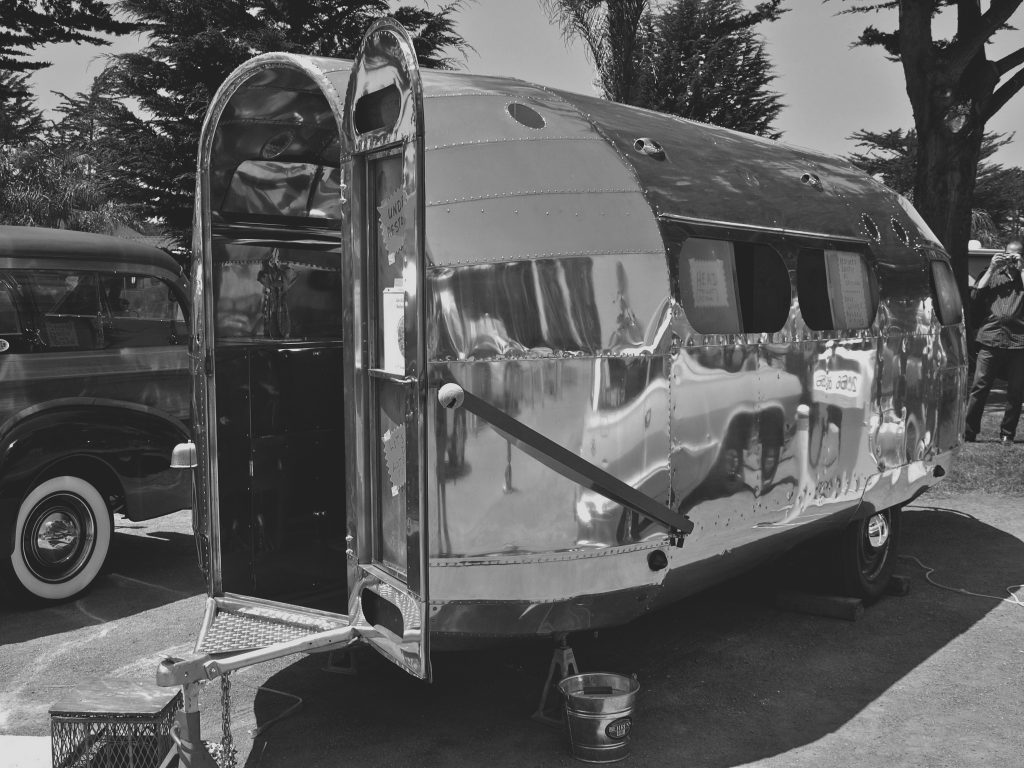Giant Rubber Bands are connected to Airstream History. And I mean Giant! This is the story of how an aviation enthusiast accidentally changed the developing RV world.
In the early 1900s, there was a burgeoning extreme sport. It wasn’t base jumping, pole sitting, hot dog eating, NASCAR, or competitive knitting. It was flying. Specifically, what were known as sailplanes. Of course the Wright brothers were the most famous in the field for their first flight but there was a small but tenacious group of enthusiasts growing. One of those enthusiasts was named Hawley Bowlus.
Hawley Bowlus
Hawley was obsessed with flight and he had the perfect setup to indulge his curious mind. His parents owned an orange grove in California. They didn’t make much money on the orchard so, eventually, Hawley’s dad built a factory for producing furniture. It was perfect. Hawley had space on his parents land where there were no trees and he had access to tools. At the age of 16 he completed his first sail plane. Then he crashed it. Back to the workshop. He built a second plane. It too crashed. By this point he was becoming known for being an authority on the west coast for sailplanes.
Students, enthusiasts, and others would filter through the Bowlus home to learn, work, and problem solve the sailplane with Hawley. It is during this time that he married a woman who enjoyed the work he did. Competition for setting records is stiff during the 1920s. The Germans are getting better and better flights and Americans felt they needed to defend the national honor as the first to fly. Hawley made his big mark in 1928 when he set a new world record for total distance flown. After this accomplishment, he helped design Charles Lindbergh’s Spirit of St. Louis. In fact, he was in the room when the telegraph came from France that Lindberg was the first to fly across the ocean.
Early Flight & The Trailer
Launching a sailplane is quite a chore. These planes didn’t have engines so they needed another source or power…giant rubber bands. Just as one would fire the bolt of a crossbow, these sail planes launched by a group of people stretching these rubber bands back and then releasing them…launching the sailplane. Then there is the matter of the wind. Hawley and his hanger ons chased the wind to get the perfect flights in…just like a surfer searching for the perfect wave.
This travel presented Hawley with a problem. He needed to be able to deconstruct his sailplane, transport it safely to a good windy location, and protect it in transit. He devised a trailer – but not just any trailer. The teardrop trailer was an option because it was small and light enough to be towed by the cars of the 1930s. But it left his aircraft exposed when mounted to the roof of the teardrop camper. Instead, he turned to what he knows best – airframe design.
He uses his extensive knowledge of aircraft design to make a large trailer that had the world’s first aluminum and rivet skin and weighs in at just 1000 lbs. In short, it was light and aerodynamic and it works perfectly for his needs. There is still one problem…wind. Hawley would pull in to a place to fly, park, set up his canvas tent, and try to sleep outside in the wind while the sail plane had a nice trailer to rest in.
On one occasion, Hawley set up the canvas tent inside the trailer. It is much easier camping in there as the tent wasn’t getting blown about all night. However, his wife encouraged him to do better. Plus, she said she didn’t like sleeping around all of the aircraft pieces. Hawley went to work installing a proper bed, dining area, and a little kitchen in his trailer which he called the Bowlus Road Chief. Thus was born an accidental business.
Airstream is Born
Less than 100 miles from Hawley was Wally Byam. Wally visited the Bowlus household a few times in the early flight days. However, his interest lay in developing his own RV. It was going to be like most of its time. Steel chassis with a wood box on the outside. It would be heavy so it had to be small – so that the low powered cars of their time could pull it. Then everything changed. Somehow Wally got his hands on a Road Chief. It was large, light, and sleek. He was sold.
Hawley Bowlus’s company made 80 Road Chief trailers before going bankrupt. Hawley was certainly a creative person but just didn’t have the managerial skills to keep his business afloat. It was shortly after Bowlus trailer went under that Wally Byam started his own company….Airstream. And then everything went badly for him.
It was the late 1930’s and the geopolitical climate is rapidly deteriorating. Airstream is slowly figuring our their process and started to turn a profit when WWII began in the United States. With the war effort, aluminum and steel are under strict ration to support the war (read more about WWII’s impact on camping). Airstream shut down. However, when the war ended, Byam starts Airstream back up and they haven’t stopped since. Byam’s trailers are not the same as Bowlus. They have the aluminum riveted exteriors and sleek look but they are not light. In fact, Airstream is still one of the heaviest RVs for its size that is in production.
Now
There’s the story of how an aeronautical engineer accidentally changed the RV industry because he needed to carry a sailplane with giant rubber bands! Hawley’s trailers are still held in high esteem. In fact, they can fetch upwards of $190,000 at auction. A recent development is the resurgence of the Bowlus Road Chief. A family in California has purchased the rights to make a whole new line of the Bowlus Road Chief trailer. They’re cool looking and super spendy.
I love it when history circles back on itself! Since I don’t plan to transport a rubber band powered airplane, I’ll stick with my teardrop.
Until next time,
Mark
Listen to this podcast here:



